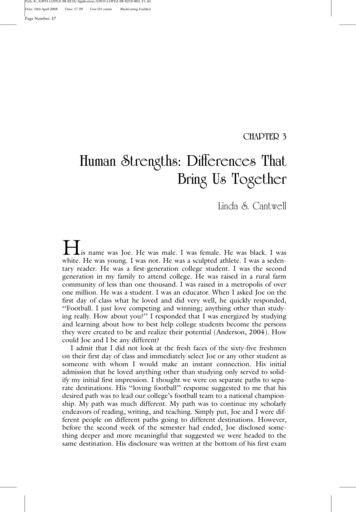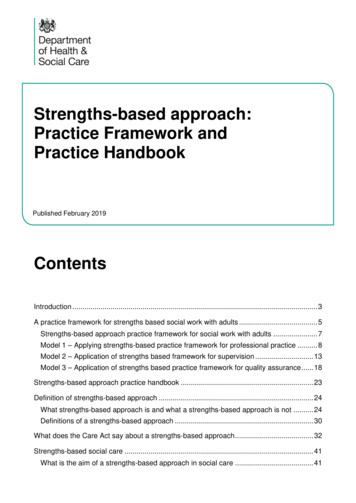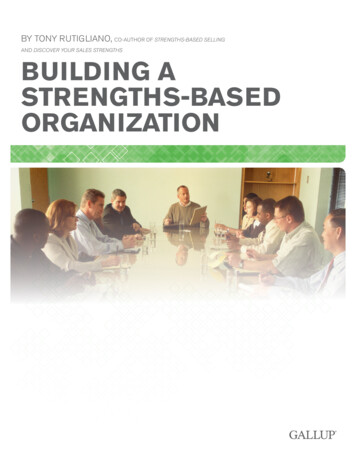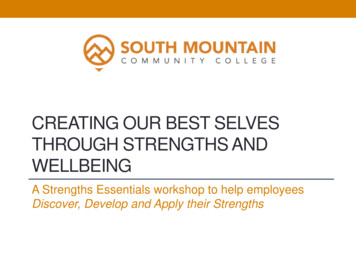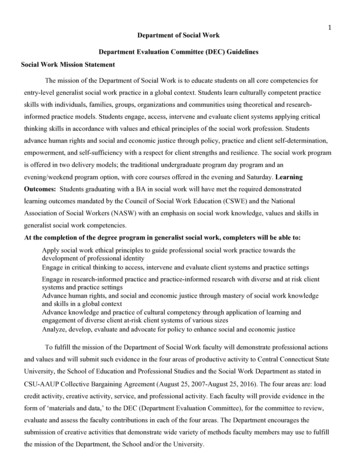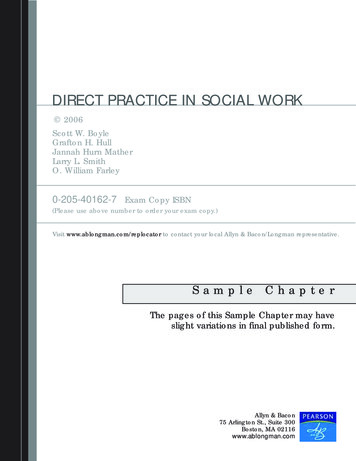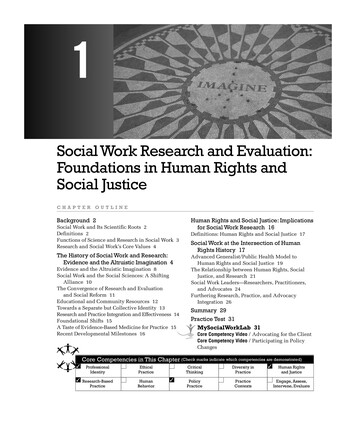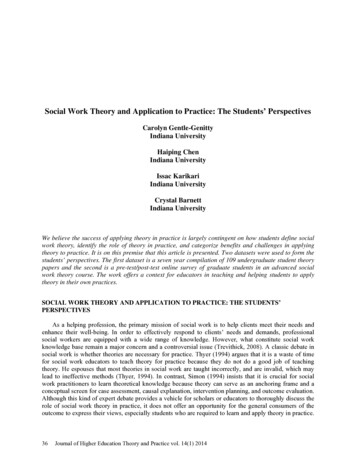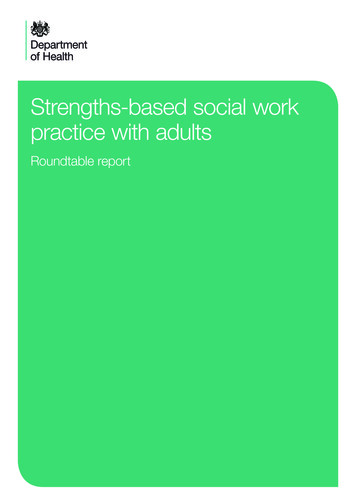
Transcription
Strengths-based social workpractice with adultsRoundtable report
ContentsForeword3Introduction4Defining a strengths-based approach to social work6Legislative and policy context8Social work and strengths-based practice11Perspectives from experts by experience/people usingservices14The evidence base15Workforce and leadership16Case study: The Importance of senior leadership inimplementing strengths-based approaches17Asset-based community development (ABCD)26Case study: Leeds Neighbourhood Networks27Local Area Coordination (LAC)28Restorative Practice (RP) – Greenwich29Three Conversations Model30Signs of Safety and Wellbeing32Making Safeguarding Personal (MSP)33Case study: Kirklees Council34What is needed to enable and supportstrength-based social work practice?36Next steps39Bibliography40
3ForewordForewordThis report is based on a workshop commissioned by the Departmentof Health and hosted at the Social Care Institute for Excellence inJanuary 2017. The event was chaired by Lyn Romeo, Chief SocialWorker for Adults and Tony Hunter, Chief Executive of SCIE.‘Excellent social work is about emphasising the use of professional engagement andjudgement, as opposed to procedural approaches, with a focus on the individual, takinga holistic and co-productive approach to keeping the person at the centre of all decisions,identifying what matters to them and how best outcomes can be achieved. It is aboutenabling people to find the best solutions for themselves, to support them in makingindependent decisions about how they live. I whole heartedly believe in taking a strengthsand asset based approach to supporting individuals and I hope this guidance note is thefirst step to building on and pulling together all the different asset based approaches thatcan help support and empower people to live the lives they want.’Lyn Romeo‘SCIE is pleased to be involved in this important initiative to help identify, explore anddisseminate strengths-based approaches to care and support, at both individual andcommunity levels. None of us operate fully independently – we use information, advice andhelp in all sorts of ways to remove barriers otherwise preventing us using our skills andexperience to the full. Strengths-based approaches have that same starting point, i.e. whatpeople can rather than can’t do. Working with people in that way is so much more positiveand liberating, and needs to underpin all good social work practice.’Tony Hunter
4IntroductionIntroductionIn January 2017 the Chief Social Worker for Adults in collaborationwith the Social Care Institute for Excellence hosted a roundtable eventat SCIE to explore what strengths-based social work with adults,individuals, families and communities really means for practitionersand people using services. The event brought together professionals,researchers and experts by experience to share examples of goodpractice and the challenges of working in a strengths-based way.It is clear that the intentions inspiring strengths-based approachesresonate both with social work practitioners and people using servicesbut there are questions and considerations which need to be exploredin making these intentions a practical, sustainable reality on theground.The aim of the workshop was to develop a common understanding in relation to the sharedcomponents of the different but complementary approaches under discussion, and start tobuild a narrative around their interpretation particularly in relation to: how social workers can enable the people they work with to identify their personal assetsand local systems of support, and build on these to find sustainable solutions.the practitioner skills and organisational models needed to implement and embedstrengths-based solutions which meet local needs.The event featured a series of short guest presentations and case studies profiling currentwork across England together with two group discussion sessions.The morning discussion focused on community assets and supporting change withinneighbourhoods, identifying the essential elements of a strengths-based approach, and thepotential barriers and enablers to working in this way with communities.In the afternoon, the focus shifted to strengths-based practice with individuals and familieswith complex needs or living in complex circumstances.
5IntroductionChallenges that emerged from both discussions revolved around how practitioners freethemselves from unhelpful institutionalised thinking and restrictive organisational processesand practices, and develop the skills and knowledge to enable effective strengths-basedpractice which delivers positive change.This report from the workshop extends the call to action around strengths-based socialwork practice and captures the key points and comments from the group discussions withsummaries of the presentations. The intention is that it will be used to inform work on thedevelopment of an overarching practice framework and more detailed implementation/supporttools. In the longer term it is hoped that the discussions captured at the workshop will lead toreviewing the current evidence and shaping new research questions around the effectivenessof strengths-based approaches.
6Defining a strengths-based approach to social workDefining a strengths-based approach tosocial work‘Strengths-based practice is a collaborative process between the person supported byservices and those supporting them, allowing them to work together to determine anoutcome that draws on the person’s strengths and assets. As such, it concerns itselfprincipally with the quality of the relationship that develops between those providing supportand those being supported, as well as the elements that the person seeking support bringsto the process. Working in a collaborative way promotes the opportunity for individuals tobe co-producers of services and support rather than solely consumers of those services.(SCIE, 2014) Care Act 2014: Strengths-based approaches. SCIE, t-and-eligibility/strengths-basedapproach/A strengths, or asset-based approach to social work practice aims to put individuals, familiesand communities at the heart of care and wellbeing, and in doing so strengthen relationshipsbetween members of that community and build social capital.It is responsive to need but focuses on the positive attributes of individual lives and ofneighbourhoods, recognising the capacity, skills, knowledge and potential that individualsand communities possess. It is based on the fundamental premise that the social workrelationship is one of collaboration, and that people are resourceful and capable of solvingtheir own problems if enabled and supported to do so.A strengths-based social work approach to working with adults is not yet a fully formed setof ideas and the evidence base for some more recent models is still emerging. However,strengths-based practice is not a new concept and reflects the core principles at the heart ofthe social work profession. The approach sees everyone including the most vulnerable andthose with long-term needs as citizens who also have rights and responsibilities, skills andexpertise.It cannot be prescriptive and there is no one-size fits-all model. Our speakers showedinterpretations vary and are shaped according to local circumstances and needs. For thisreason, approaches may not lend themselves to being easily replicated and scaled up but dosupport the better deployment of existing resources by building on assets already present.
7Defining a strengths-based approach to social workCritical to successful implementation is a change in culture not just in social services or localauthorities, but across health and social care systems and in society as a whole. Shifting froma paternalistic care management viewpoint rooted in a deficit model to a focus on what theorganisations and citizens of an area can do, their assets and potential informed by a deepunderstanding of what’s happening on the ground in local communities. It acknowledges thecomplexities of the socio-economic political context in which people live and the impact ofmaterial disadvantage on particular individuals and communities.Choice, control, citizenship and connectedness are common themes underpinning allstrengths-based work. A strengths-based mind set draws extensively on personalisation andco-production, working in partnership to develop co-designed solutions which prevent harmand abuse, reduce obstacles and discrimination, and restore and support family relationships.A strengths-based approach starts with a different conversation.
8Legislative and policy contextLegislative and policy context‘For far too long people’s needs assessments have been driven by the service on offer orthat can be provided in a particular area such an approach fails to recognise the richnessand complexity of people’s lives and fails to support or promote truly person-centred care.’(CQC) Care Act Factsheet 2: Who is entitled to public care and support (Departmentof Health, 2016) t-2014-part-1factsheets/care-act-factsheets‘The Care Act opens the door to liberate existing good practice and to cultivate deeperpractices that support what matters to people, and enables them to achieve the lives theywant for themselves’.(Cormac Russell) Community social work: the shift from what’s wrong to what’sstrong (Lyn Romeo blog, DH, April s-strong/Social workers practice within a framework of legislation and government policy relating tochildren, families and adults. The principles underpinning a strengths-based approach insocial work complement both health, social care policy, and legislative requirements.The implementation of the Care Act 2014 has been a key policy driver in the development of anew vision for adult social care. The Act sets out a clear legal framework for the way in whichlocal authorities should protect vulnerable adults and puts the broad concept of individualwellbeing at the centre of practice:‘The core purpose of adult care and support is to help people to achieve the outcomes thatmatter to them in their life.’(Care Act 2014) Chapter 1, Care and Support Act Statutory Guidance (DH, y-guidance#chapter-1
9Legislative and policy context‘As part of this person-centred, outcomes-focused approach, the Act requires that socialworkers and care professionals ‘consider the person’s own strengths and capabilities, andwhat support might be available from their wider support network or within the communityto help’ in considering ‘what else other or alongside the provision of care and support mightassist the person in meeting the outcomes they want to achieve’.(Care Act 2014) Chapter 1, Care and Support Act Statutory Guidance (DH, y-guidance#chapter-1Adopting an asset or strengths-based approach to any intervention and particularly toassessment is one of the critical principles underpinning the Care Act, together with coproduction, personalisation and the need to work preventatively.It was recognised by the College of Social Work at the time the new legislation was passedthat the implementation of the changes embodied in the Act would demand significant culturaland attitudinal changes.Meeting needs rather than providing services is integral to the Care Act as is the wellbeingprinciple. This means promoting individual aspirations, enhancing independence andwellbeing and maximising autonomy – supporting people to live their lives in the way thatthey choose. The emphasis is on outcomes focused social work practice rather than caremanagement processes.
10 Other relevant legislation in a strengths-based contextHuman Rights Act (1998)Social workers help individuals realise their rights every day and are ideally placed to helpcommunities claim their collective rights. Social workers provide empowering, rights-basedpractice that develops individual and community capacity.Mental Capacity Act (2005)Developed to coordinate, bring together and simplify the law about the care and treatmentof people who lack capacity. It builds on common law and is designed to protect the rightsof individuals and to empower vulnerable people. Social workers working with adults shouldcontinually be aware of capacity in relation to specific decisions that vulnerable adults arerequired to make; particularly where a specific decision may place themselves or others atrisk.Localism Act 2011Facilitates the devolution of decision making powers from central government to individualsand communities.Equality Act (2010)Social workers have a key role to play in embedding the Equality Act 2010 anti-discriminatoryobjectives in practice by improving information collected about and provided to people whouse services.Public Services (Social Value Act) 2013Requires people who commission public services to think about how they can also realisewider social, economic and environmental benefits and develop new and innovative solutionsto difficult problems.
11 Social work and strengths-based practiceSocial work and strengths-based practice‘Social work practice is nothing if it is not about enabling people to use and develop theirstrengths and ability.’(Dr Ruth Allen)At the workshop Dr Ruth Allen, Chief Executive of the British Association of Social Workers(BASW) reflected on the six ‘P’s’ of social work (practice, professionalism, public and pressperception and politics) and the way they define important aspects of strengths-basedpractice with adults: The opportunity strengths-based approaches offer for social work to define itsprofessionalism.The development of practice capabilities for authentic strengths-based work.The need to continually evaluate practice through co-production with people who useservices.The opportunity to develop new public perceptions of social work demonstrating the waysocial workers enable positive change.The expression of the empowering political dimension of the social work profession.Strengths-based approaches have clear historical links with community development socialwork of the 1970s, another period of austerity and public service cuts. Person-centredapproaches which aim to develop citizenship and community capacity reflect traditional socialwork values in that they are respectful and empowering of the oppressed and vulnerablein society. Social workers act as advocates for people and want the best for them and thiscollaborative relationship is the cornerstone of the type of outcomes achieved.In recent decades though there had been a critical shift to a more process driven assessmentand case management approach which has been criticised for encouraging dependency anda tick-box approach to the provision of support.The Knowledge and Skills Statement for social workers in adult services (2014)acknowledges the importance of the Care Act in signalling a move away from care
12 Social work and strengths-based practicemanagement as the overriding approach to working with adults, and highlights the relationalapproach of the social work role.‘Social workers should enable people to experience personalised, integrated care andsupport them to maintain their independence and wellbeing, cope with change, attain theoutcomes they want and need, understand and manage risk, and participate in the life oftheir communities. Social work should focus on the links between the individual, their healthand wellbeing and their need for relationships and connection with their families, communityand wider society.’As the presentations at this event showed, strengths-based approaches are not new andexamples of excellent strengths-based practice can be found in many localities which predate the implementation of the Care Act. However, the Act serves to embed strengths-basedapproaches and underpin the repositioning of social work practice with adults.The approaches described by the guest speakers draw upon and are informed by anestablished range of theories, models and ways of working with people. These includenarrative approaches, appreciative enquiry, disability rights, systemic family and solutionfocused therapies, motivational interviewing, co-production and personalisation. All recognisethat people are experts in their own lives, and have the potential to reframe the narrative oftheir lives in collaboration with professionals who share their knowledge and can help navigatecomplex support systems. The social work role is a facilitative one, working with people andbringing people, groups and communities together. The power of positive language andpersonal stories are recognised as very important in this context.A strengths-based approach: is rights based and person-centredhas a clear ethical and values based positionworks in a place based wayrecognises the limits of institutional work and takes an interdisciplinary, holistic view, seeingpeople as resourceful and resilient in the face of adversity acknowledges that people are a lot more than their care needs, are experts in their ownlives and take the lead in their own care acknowledges that notions of community are subjective – for some family, others online orlocal neighbourhood reframes the narrative and tells the ‘good’ stories about what people have done, what theydo every day and what they have achieved – ‘we are all amazing people’ draws upon a person’s resources, abilities, skills and connects with their social networksand communities –whether actual or digital uses explicit methods to identify strengths and assets – both soft assets (personalinterests, skills, relationships) and hard assets (finances, housing, health)
13 Social work and strengths-based practice is goal orientated and outcomes focusedis collaborative and based on reflective conversation, encouraging the person to makesense of where they are and making meaningful choicesis respectful – not making assumptions, non-judgementalis hope-inducing!A strengths-based approach is not: a return to the old days of family and community social services departments. Itacknowledges that aspects of past practice were positive but it looks forward rather thanback. ‘We need to build on what’s good and marry with new approaches’simply about tools or methods – but about different concepts, structures and relationshipsshorthand for there is no or reduced funding for service development so we need to getpeople and communities to do more for themselvesabout going back to the days when volunteers did everything. When people volunteer itshould not be an impositionanother redesign of a set of forms or way of conducting social work assessmentdriven by the need to save money – although as some approaches show, there may becost savings to be made over time due to a reduction in demand for statutory services
14 Perspectives from experts by experience/people using servicesPerspectives from experts by experience/people using services‘A life worth living until I die.’‘Make strengths-based commissioning come alive in the place I live.’Asset-based approaches continue to be a popular topic of ongoing debate in social work,health and care. There are some concerns that the concepts and terminology are in dangerof misappropriation at a time of public austerity, and may be misused to justify budget cutsand closure of existing services leaving vulnerable people potentially even more vulnerable.There is also a risk that high profile elements of approaches are picked up on and appliedin the hope of a quick return which creates unrealistic expectations, leading to frustrationand disappointment. The need for structural support to ensure engagement and overcomechallenges around mobility and accessibility is also a concern. Listen, don’t make assumptions or judge, respect.Don’t confuse needs with service categories.Don’t downplay the existence of very real problems people and communities may befacing.Allow people to define their own risk.Acknowledge that needs can change.Know your community, spot where assets and drive exist in the community, having will isan asset, ‘people are shafted by systems and hierarchies’.Social workers should be advocates and allies.The importance of neutral spaces – people don’t always want somebody to come to theirhome.Don’t leave services out altogether, withdrawal or loss of services and programmes canleave people feeling vulnerable and bereft.Work with carers to develop understanding of strengths-based practice as some expressfears over losing support for the person they care for.Consider what the unintended consequences of strengths-based approaches might be.Listen to complaints, feedback and compliments and link these to evaluation.
15 The evidence baseThe evidence base‘No data without a story and no story without data.’Hard evidence of the impact and effectiveness of strengths-based approaches is stillemerging although some models have a longer history and more established evidence basethan others, for example ABCD and Local Area Coordination. Lack of an evidence base oraccess to the right type of evidence with sufficient intellectual rigour was highlighted as abarrier in the group discussions. This was particularly in relation to which type of strengthsbased approach or model works best in which scenario and how the impact can bemeasured effectively.The published qualitative evidence supporting the adoption of strengths-based approaches inadult social care shows that social networks are improved and wellbeing enhanced but in partevidence can be difficult to synthesise because it relates to a range of different populationsand ‘problem’ areas. The workshop presentations however showed that strengths-basedapproaches do apply across a range of practice settings, localities, client groups andrelationships.The discussions highlighted that practitioners need to be better at sharing evidence andgood practice to ensure that any practice framework developed can demonstrate a strongknowledge base, theoretical depth, methodologies and skills sets required. In terms of accessto relevant data the observation was made that local authority data collection can be veryvariable and not always adequate for evaluation purposes.It was noted that strengths-based approaches must be interdisciplinary and that social workcan draw on and adapt practices from other sectors, particularly health.Questions raised in the group discussions reflect the challenges: Do strengths-based approaches work for everyone including those with the highest/mostcomplex needs?How do we know which type of approach works best and what does ‘good’ look like?How do we establish a baseline for the things we want to change?How do we evaluate something that is essentially a dynamic approach and ensure thatfeedback from people using services is included – what tools are available to help withthis?How do we present a convincing mix of quantitative and qualitative data to evidenceimpact including data about costs?
16 Workforce and leadershipWorkforce and leadershipWhat does it mean to lead and manage in a strengths-based way and how does a strengthsbased organisation operate?Skills for Care sees benefits for the workforce when asset-based and community skillsdevelopment approaches are used. An evaluation of their Skills around the Person (SATP)programme found that the resourcefulness of individuals and their communities is substantialbut often unrecognised. The delivery of the programme was characterised by the willingnessof practitioners to experiment and be creative in enhancing service users’ independence andautonomy. It was noted that the SATP approach improved staff retention and motivation forwork whilst also reducing levels of staff sickness.The point was made in the group discussions that staff cannot be ordered to work in astrengths-based way, the motivation is value-driven and must come from within but thatstrong leadership is essential in modelling different behaviours and leading organisationalchange. More clarity is needed about the role of the social worker in relation to a strengths-basedapproaches – guidance would be welcome.Practitioners need to re-examine and reflect on the way they work and focus more onthe future than the past, solutions not problems. A strengths-based approach needs aworkforce with personal resilience.Practitioners must feel confident in taking positive risks.Workforce continuity is an important factor.Practitioners need to be enabled to move from task-focused supervision to reflectivepractice and strengths-based supervision models.What implications does strengths-based work have for social work training and CPD?How do practitioners actively work with the community not only to understand its culturesand strengths but also to develop inclusive workforce planning?What tools might be needed to support the implementation of strengths-based workingand organisational self-assessment?When practitioners are working in casework roles under extreme time and financialpressures, how can they be freed up to create the right conditions for bottom-up work andfoster social capital?
17 Case study: The Importance of senior leadership in implementing strengths-based approachesCase study: The Importance of seniorleadership in implementing strengths-basedapproachesCath Roff, Director of Adult Social Care Leeds City Council‘The starting point is the values of the senior management team: they provide the foundationstone on which strategies and services are developed. If you believe in a model of social carethat is rights-based and rooted in autonomy and citizenship then you are half way there. Thewhole senior leadership team is passionate about a strengths-based approach and supportand challenge each other in each measure.When I started my role in Leeds two years ago, I spent a lot of time getting out of the officetalking to frontline staff to better understand the reality of their working lives. The messagewas loud and clear that the social work service felt pressurised, bogged down in paperworkand locked into a process that was not satisfying either for them nor the people we aim toserve. It seemed that they were increasingly becoming the “border patrol”, policing an evertightening interpretation of eligibility criteria in order to manage reducing budgets. None of uscame into social care to do that so it was time to come up with an alternative. The aspirationfor a strengths-based approach is clearly stated in the Care Act: the challenge was to convertthat into practice.We set out the foundations and principles against which we are developing strengths-basedsocial care in Leeds. They have become rooted in Leeds folklore as the “rule of three”: Don’t break the lawDon’t blow the budgetDo no harmApart from that, I said I trusted social workers to do the right thing, to do well what they wereprofessionally trained to do and they had permission to practice in the right way.If they thought the forms we currently had were getting in the way, they had permission to tearthem up and come up with something better. This is how we got rid of our 27 page tick-box“guided self-assessment form” and now have a two-sided Conversation Record that is CareAct-compliant, has three key questions and can grow in size depending on what the socialworker thinks is proportionate to record. This had allowed social workers to challenge the oldmethodology and bring their practice and the people they serve to the centre of what we aredoing in Leeds. They are confident that they will be supported to break through the barriers ofbureaucracy and process and they know that I have a personal interest in what they do.
18 Case study: The Importance of senior leadership in implementing strengths-based approachesI chair the Strengths-based Social Care Project Board every month which invites socialworkers and team managers to present on progress in their area. I have to say it is the bestmorning of my month – the enthusiasm, pragmatism and innovation from the frontline is justbreath-taking. There is a real buzz across the whole of the social work service. I promised toliberate social work and they have absolutely grasped the opportunity and run with it.We have spent time talking about what are the ingredients of a good life and this is embeddedin our refreshed “Better Lives” strategy for people with care and support needs. It has helpedstaff think more creatively about solutions and by embedding peer challenge (in a constructiveway) in team practice to come up with plans that are as community-based and support theperson to have as good a life as possible from every contact that we have with them withouthaving recourse to funded support plans wherever possible.I have now done a vlog as a new way of reaching even more people and we are going touse it at the start of any future recruitment for new staff as it says what we are about in fourminutes. We hope any social worker would want to come to work in a city which had a SeniorLeadership Team who understands and commits to the vision of genuine strengths-basedsocial care.’
19 Case study: The Importance of senior leadership in implementing strengths-based approachesA guide to carrying out and recordingThe Conversation RecordThe conversation record has been created to support adifferent type of conversation/assessment to the one previouslyrecorded following a (SSA) self-supported assessment. Ourconversations are now more focused on what people want to tell usand what they want us to know, not just about what we want to askthem, which is why there are no service or needs led questions.However, where there are specific concerns or risks, you will
Defining a strengths-based approach to social work 6 Legislative and policy context 8 Social work and strengths-based practice 11 Perspectives from experts by experience/people using . services 14 The evidence base 15 Workforce and leadership 16 Case study: The Importance of senior leadership in . implementing
